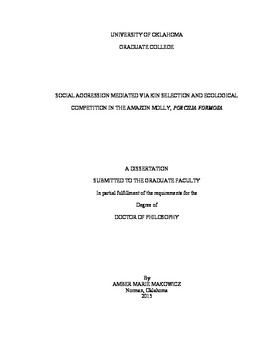| dc.description.abstract | The maintenance of sexual reproduction is still a largely unresolved question in evolutionary biology, and one of the most puzzling aspects of this is the co-existence of sexual and asexual species. This often leads to widespread niche overlap, posing an interesting challenge to the Competitive Exclusion Principle. Despite this, there seems to be something preventing either the sexuals or asexuals from outcompeting the other. I investigated this using the clonal fish, the Amazon molly (Poecilia formosa). Females produce daughters that are genetically identical to themselves and each other, and are sexual parasites of their parental species, the sailfin molly (P. latipinna) and the Atlantic molly (P. mexicana). They overlap and compete in many aspects of their ecological niche, behavioral, and life history parameters. The ‘behavioral regulation hypothesis’ predicts that the maintenance of this species complex is driven by adaptive male mate choice. However, little attention has been given to counter-adaptations that may allow Amazon females to thwart male mate choice. One of the most likely means of circumventing male choice is aggression towards the preferred sexual females. Here, I investigated two questions: 1) How costly is female-female aggressive behaviors in Amazon mollies in comparison to sailfin females, and 2) How does the social environment help regulate aggression in Amazon females (i.e., kin selection). First, I found that Amazon females were on average more aggressive over time when compared to their sexual hosts, sailfin molly females. Amazon females, however, incurred a higher cost of being aggressive. Aggressor females of this species had a lower body fat content than their conspecific recipients. By contrast, sailfin females showed no differentiation between aggressors and recipients. Secondly, Amazon mollies have the ability to distinguish between different clonal lineages: clonal females prefer genetically identical, clonal sisters to slightly different clones. Intriguingly, they do this using multiple sensory modalities, including visual and/or chemical cues. In natural water, wild caught females preferred clonal sisters when chemical information was available, while the preference using visual information was non-existent. Most importantly, however, they scale their aggressive behaviors according to the relatedness to other females: they are more aggressive to non-related clones. In conclusion, female competition can be quantitatively measured and that these aggressive behaviors are costly to perform. I demonstrate that even in species with very small genetic differences between individuals, kin selection can be adaptive. Indeed, even minute differences in relatedness (extremely close kin are favored over very close kin) can provide enough substrate for the evolution of kin recognition. Their discriminatory abilities and regulation of behavior provides a powerful example of natural selection in species with limited genetic diversity. | en_US |
